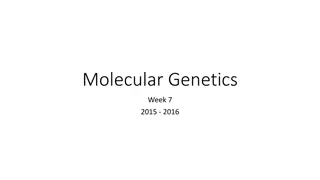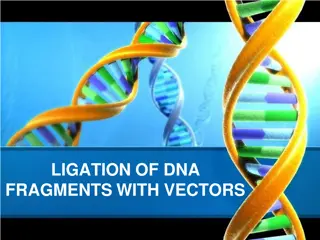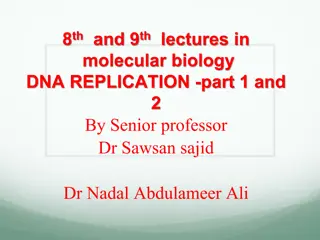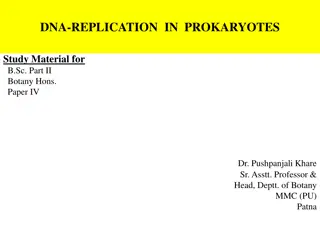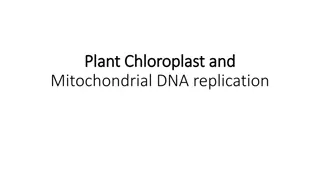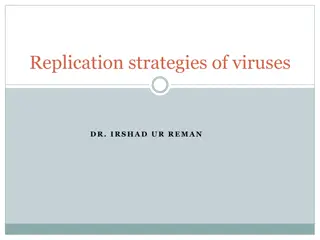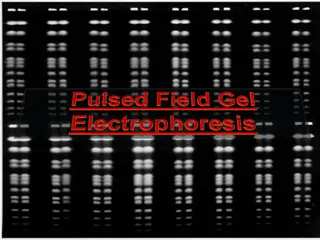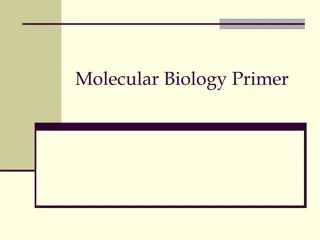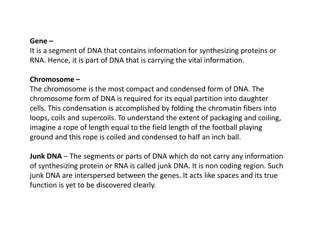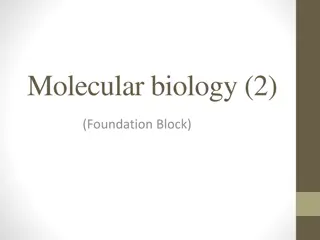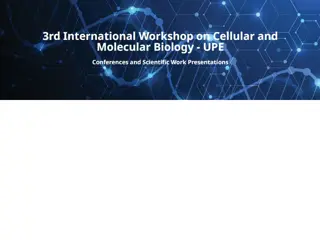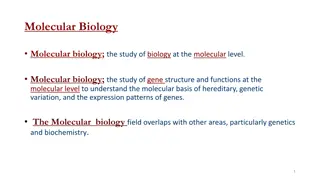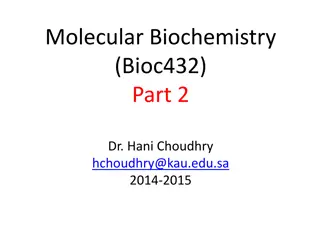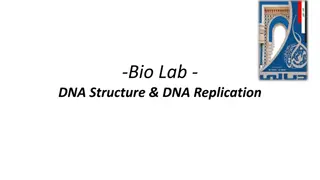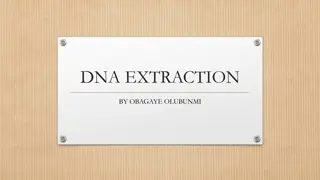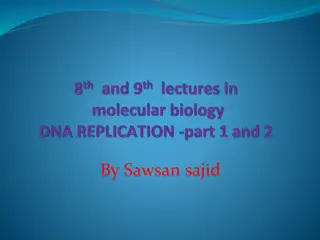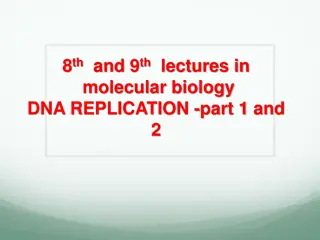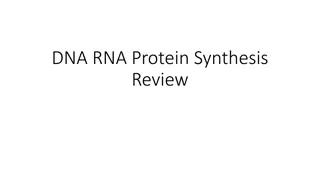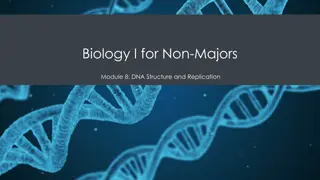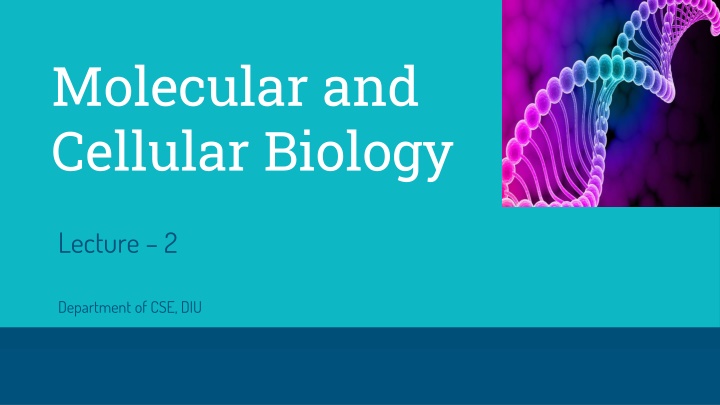
Exploring Molecular and Cellular Biology: Lecture Insights
Delve into the world of molecular and cellular biology through this lecture series. Discover the differences between Eukaryotic and Prokaryotic cells, explore the intricacies of nucleic acids, and unravel the fundamental units of life. Understand the critical role of DNA, RNA, and proteins in the functioning of cells and life processes. Dive deep into the structure, replication, and significance of these molecules. Enhance your knowledge of cell specialization, tissues, and organs to comprehend the complexity of living systems. Embark on a journey to uncover what life is truly made of.
Download Presentation

Please find below an Image/Link to download the presentation.
The content on the website is provided AS IS for your information and personal use only. It may not be sold, licensed, or shared on other websites without obtaining consent from the author. If you encounter any issues during the download, it is possible that the publisher has removed the file from their server.
You are allowed to download the files provided on this website for personal or commercial use, subject to the condition that they are used lawfully. All files are the property of their respective owners.
The content on the website is provided AS IS for your information and personal use only. It may not be sold, licensed, or shared on other websites without obtaining consent from the author.
E N D
Presentation Transcript
Molecular and Cellular Biology Lecture 2 Department of CSE, DIU
CONTENTS 1. Cell -Eukaryotes VS Prokaryotes 2. Nucleic Acids 3.1. DeoxyriboNucleic Acid (DNA) * DNA Structure * DNA Replication 3.2. RiboNucleic Acid (RNA) * RNA Structure * Major RNA Types
1. Cell Let s learn about Eukaryotes and Prokaryotes
Fundamental working units of every living system. Cell specialization in multi-cellular organism. Tissues are groups of cells for a particular function. Fourteen major tissue types Bone, muscle, nerve etc. Organs are formed More than 200 different cell types With lots of variety in every sense But the genetic code is same Cells Muscle Blood Bone Nerve Fat
2 types of Cells 1. 2. Eukaryotic Cells Prokaryotic Cells
Eukaryoti c Cells Single or Multi Cell Are called Eukaryotes Have Nucleus Have membrane bounded organelles Have chromosomes inside Nucleus Seen in most of the life forms
Prokaryoti c Cells Single Cell organism Are called Prokaryotes No Nucleus No other membrane bounded organelles One piece of rolled up DNA floating in cellular fluid Mostly some forms of very ancient Bacteria
All Life depends on 3 critical molecules DNAs Hold information on how cell works RNAs Act to transfer short pieces of information to different parts of cell Provide templates to synthesize into protein Proteins Form enzymes that send signals to other cells and regulate gene activity Form body s major components (e.g. hair, skin, etc.) Are life s laborers!
Building Blocks of Nucleic acids DNA/RNA are polymeric chain on nucleotides Three parts of Nucleotides a nitrogenous base, a five-carbon-atom sugar and a phosphate group
Nucleic acids Bases Adenine (A), Guanine (G) Cytosine (C) Thymine (T) Uracil (U)
3.1 DeoxyriboNucleic Acid (DNA) Carrier of genetic instructions
DNA Structure Double Helix Structure (Watson and Crick, Nature 1953) Two complementary antiparallel strands, one runs from 5 to 3 end and another runs from 3 to 5 end 3 major parts Nitrogenous Base, 5-Carbon Deoxyribose Sugar and Phosphate Group Four nitrogenous bases Adenine (A), Cytosine (C), Guanine (G), Thymine (T) A-T is Double Hydrogen Bond and G-C is Triple Hydrogen Bond DNA is more stable than RNA due to its Deoxyribose Sugar Structure
DNA Replication Initiation -Helicase enzyme unwinds DNA strands -Replication fork is created -RNA Primer is created by Primase enzyme -Primer is starting point of elongation Elongation -New DNA Strand grows 1 base at a time as complimentary of leading strand (5 to 3 ) -DNA Polymerase enzyme controls it -Complimentary strand of lagging strand is created in small fragments called Okazaki Fragments (3 to 5 ) Termination -Exonuclease enzyme removes all the primer sequences from new strands -Again, DNA Polymerase fills the gaps -DNA Ligase enzyme seals all the gaps * DNA Replication is Semi-Conservative, because, in new sets of DNA, one strand is newly created but the other strand comes from the ancestor.
3.2 RiboNucleic Acid (RNA) Protein Coding and Carrier
RNA Structure Single Helix Structure Single Strand which generally runs from 5 to 3 3 major parts Nitrogenous Base, 5-Carbon Ribose Sugar and Phosphate Group Four nitrogenous bases Adenine (A), Cytosine (C), Guanine (G), Uracil (U) A-U is Double Hydrogen Bond and G-C is Triple Hydrogen Bond RNA is less stable than DNA due to its Ribose Sugar s structure
RNA Types Ribosomal RNA (rRNA) Protein and rRNA combinedly forms ribosome Messenger RNA (mRNA) Carries a genes coding message for protein from Nucleus to Ribosome Transfer RNA (tRNA) Transfers specific amino acid sequence to ribosome to form Protein Non-Coding RNA Not translated into protein. Ex tRNA, rRNA Catalytic RNA Catalyze chemical reaction. Double Stranded RNA Contains complementary strands like DNA. Induces gene expression.
Reference Video https://youtu.be/C1CRrtkWwu0 https://youtu.be/TNKWgcFPHqw


